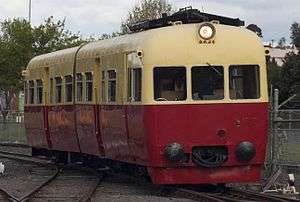Tasman Limited
The Tasman Limited was a passenger train operated by Tasmanian Government Railways (TGR) on the Main and Western lines between Hobart, Launceston and Wynyard from April 1954 until July 1978.
 DP railcar, as used on the initial Tasman Limited services in 1954/55 | |
| Overview | |
|---|---|
| Service type | Passenger train |
| Status | Ceased |
| First service | April 1954 |
| Last service | 28 July 1978 |
| Former operator(s) | Tasmanian Government Railways |
| Route | |
| Start | Hobart |
| End | Wynyard |
| Distance travelled | 378 kilometres |
| Average journey time | 8 hours |
| Service frequency | daily |
| Line(s) used | Main Western |
The service has the distinction of being the last ever regularly scheduled passenger train service in Tasmania.[1]
History
With the introduction of the X class in 1950, Tasmania became the first state in Australia to operate mainline diesel locomotives, and the creation of an intercity express such as the Tasman was further established by the modernisation of the system and infrastructure, such as the redevelopment of Hobart's railway station in 1951.
The service initially began in April 1954, using articulated DP class railcars built in 1949/50 by Commonwealth Engineering. [2]
Operating daily, Mondays to Saturdays, the railcars carried name-boards depending on their direction of travel:
- Hobart to Launceston was The Tamar
- Launceston to Wynyard was the Table Cape
- Wynyard to Launceston was The Launcestonian
- Launceston to Hobart was The Derwent.
The Tasman departed Hobart at 08:35 and arrived in Launceston at 13:08, and Wynyard at 16:45. Stopping only for passengers at Derwent Park Junction, several intermittent stops happened in between due to scheduling conflicts on Tasmania's single lines, such as at Parattah in the state's Midlands. The train would often have to wait here for down-line freight to move on through, before it could proceed. [3]
In December 1955, with an increase in patronage and the availability of purpose-built ACS articulated saloon and buffet carriages, the Tasman began being drawn by X class locomotives, often with a headboard for the service. [4] Y class locomotives were also used.
Taking approximately eight hours to wind its way through the countryside to reach its final destination, the Tasman was never considered a true "express" train even by the standards of the day; however, the TGR advertised it as such and along with its specialised service and arrangements, it was considered the state's great luxury passenger train.[5][6]
In the loco-hauled era, Tasman Ltd did not go into Launceston. The eastbound and westbound crossed at Western Junction; a connecting train ran out from Launceston and back, making journeys from anywhere to anywhere possible. [7] Some of the ACS carriages had tray tables; others had the hostess place a cushion on a passenger's knees to support the meal tray. The link train was upgraded to provide tea & coffee service. A typist was sent from the TGR office pool for the short return journey, then returned to her main work. Towards the end, there was an experiment playing specially-recorded music from Hobart Symphony Orchestra over the carriage public-address system. It was drowned out by the rumble from the undergear when moving. Not necessarily into the Tasman Ltd era, TGR had been the only system in Australia to operate UK-style mechanical mail-exchange equipment.
Decline and termination
During the 1960s and 1970s, investment in the railways of Tasmania was sufficiently low, that by 1974 all suburban and regional passenger services were halted "temporarily". With the influx of greater car ownership and more investment in the state's highway system than rail, the Tasman became the last of the daily passenger trains.
On 1 March 1978, the TGR was taken over by Australian National who reduced the service from six trips a week to three due to low patronage, and not long after it was announced that Tasman Limited was no longer viable. The last service departed Hobart on 28 July 1978.
A railcar and some of the rolling stock has been converted into a series of shops called the Margate Train outside Margate, Tasmania.
References
- Stokes, H.J.W. (1978) The Rise and Fall of the Tasman Limited, ARHS Bulletin, vol XXIX, number 493 November 1978, pp.237 - 244.
- ""TASMAN LIMITED" TO BE DAILY SERVICE". The Advocate (Australia). Tasmania, Australia. 9 September 1954. p. 9. Retrieved 9 June 2018 – via National Library of Australia.
- "TWO-WAY TASMAN LIMITED DAILY ON ALL LINES". The Examiner (Tasmania). CXIII (223). Tasmania, Australia. 27 November 1954. p. 11. Retrieved 9 June 2018 – via National Library of Australia.
- Photograph - Hobart Railway Station, Suburban Diesel train "Tasman Limited" inscribed on back, LINC Tasmania, 1957, retrieved 9 June 2018
- Victorian Railways corporation (VA 2876) (1980), POSTER SEE TASMANIA IN RAIL COMFORT BY TASMAN LIMITED (VPRS 12903/P1 Box 691/10), Public Record Office Victoria, retrieved 9 June 2018
- See Tasmania in rail comfort, by Tasman Limited [picture], LINC Tasmania, 1965, retrieved 9 June 2018
- Transport Commission 'Rail and road in Tasmania' nd, but ~1956-59 (the Holden model depicted in a hire-car advertisement).